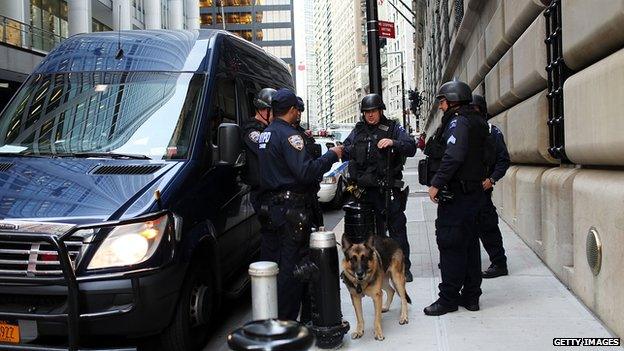Who, What, Why: What happened to crime in New York City?
- Published

New York City recorded a day with no violent crime. When did Gotham get so safe?
For more than 36 hours, external in New York City, no-one was shot, stabbed, or otherwise killed. The crime freeze began after 22:25 on Sunday, when a man was shot in the head, and continued until another man was shot at 11:20 on Tuesday.
Though the break in violent crime marked the first time in recent memory such an event had occurred, the figure doesn't surprise criminologists.
"I'm surprised it's just the first day this has happened," says Alfred Blumstein, a professor of public policy at Carnegie Mellon University in Pittsburgh, Pennsylvania.
Considering, says Blumstein, that there were only 472 homicides in New York last year, with this year on track for even fewer, the odds of a violent-crime free day are favourable.
"That's an average of about 1.5 homicides a day. Some days you might have three, or five or 10, and some days you have none," he says.
While violent crimes like stabbing and non-fatal shootings are more common, it's still well within the realm of possibility that some days would be violent-crime free.
Still, it's important to note that crime statistics - especially when it comes to assaults and injuries - can be imprecise.
"The police department count of non-fatal shootings and stabbings is probably an undercount," says Frank Zimmering, chair of the criminal justice research programme at the University of California, Berkeley, and author of The City That Became Safe: New York's Lessons For Urban Crime and Its Control.
"Somewhere in New York City it is not unlikely that someone was shot or stabbed."
The truth is that New York's crime rate has been on the decline since the 1990s, when crime overall declined in the US by 45%, in part due to a tapering off of the crack-cocaine problems in the 1980s.

Times Square, once seedy and dangerous, is now a commercial tourist attraction
"That tailwind helped New York, too - but then the New York reductions lasted longer and were twice as big," says Zimmering.
"And while the rest of the country saw a stabilisation of crime rates in the 2000s, New York City's numbers continued to drop.
"[In 2007] the talking heads were predicting big trouble on the crime front because the economy went to hell in a hand basket and the country was letting out as many people in prison as it put in."
"What happened as a consequence is that crime went down. What I can tell you is that it has been a pretty general pattern. What I can't tell you is what is the dynamic that is driving that general pattern."
In his book, Zimmering finds that demographic shifts don't account for the changes.
Minority populations are typically the victims of violent crime, but crime went down as New York's minority populations increased. Nor were there significant drops in drug use.
The answer seems to lie with more and better policing - but what constitutes "better" policing is still up for debate.

Thanks in part to Comstat, a sophisticated statistics tool, external, New York police were better able to identify crime patterns and violent "hotspots" in the 1990s.
From there, top brass in the police force were able to meet together to develop a more consistent battle plan against the city's crime.
"It was much more of an attempt at being more sophisticated at policing than had typically been the case," says Blumstein.
These strategies included increased police presence, busting of outdoor drug peddling, and more controversial methods like "stop-and-frisk, external" where young men in high-crime areas are stopped and patted down for illegal weapons and drugs.

But it's difficult for criminologists to determine which of these methods work and how effective they are individually.
"What scares the hell out of me is that we're not rigorously testing anything," says Zimmering.
Perhaps it's possible that the lower crime rate has allowed police to focus on a more altruistic approach.
At around the same time that New York's crime-free wave was making headlines, a New York City police officer became a viral sensation , externalafter he was photographed giving a pair of new boots to a barefoot homeless man.